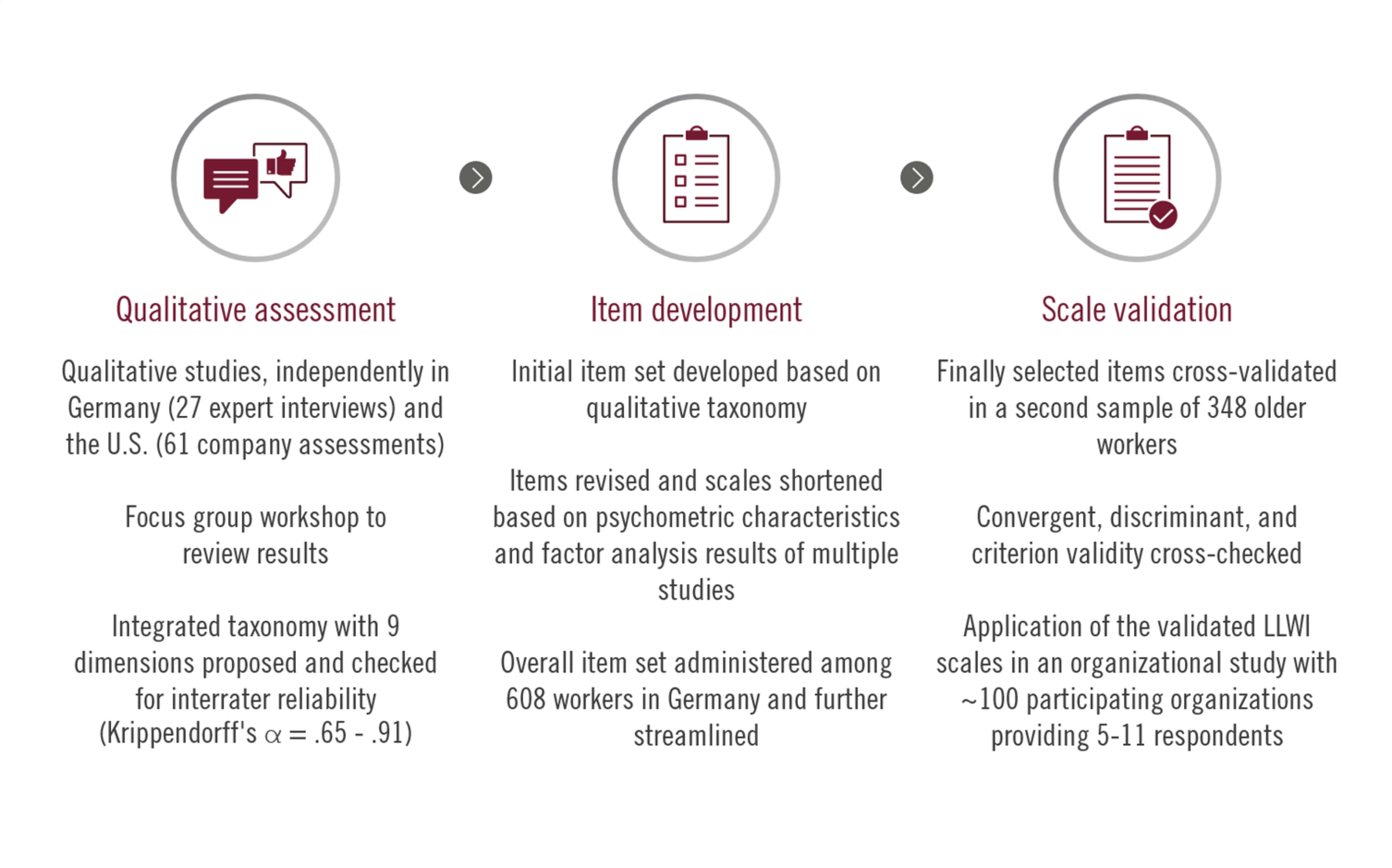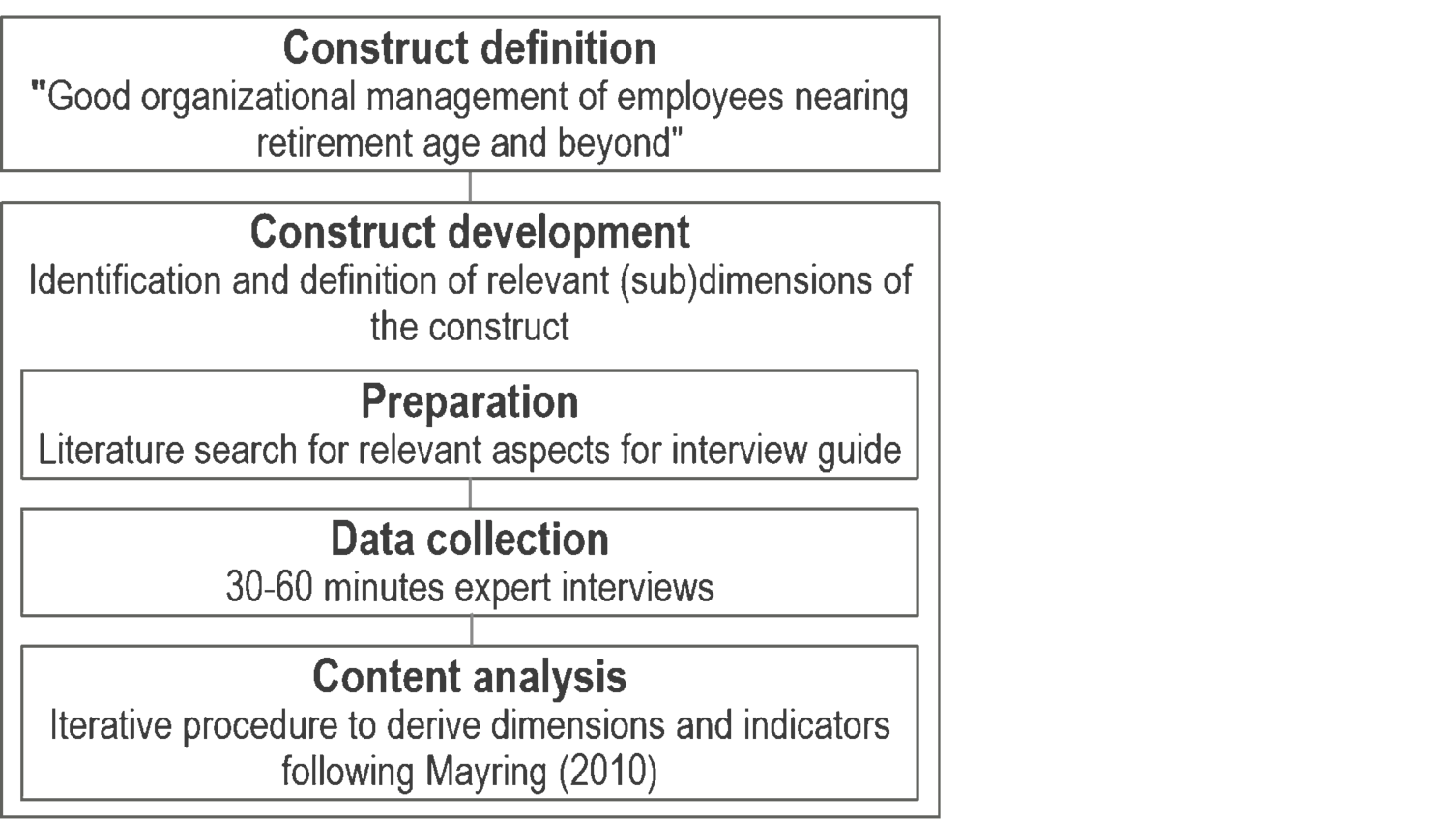Development of the LLWI
The development of the LLWI is based on extensive qualitative as well as quantitative research. The following illustration shows a general outline of the research process. Detailed information regarding the individual steps is provided below.
 ©Prof. Dr. Jürgen Deller et al. (2020)
©Prof. Dr. Jürgen Deller et al. (2020)
Qualitative Assessment
German dataset (Wöhrmann et al., 2018)
This qualitative research project in Germany was conducted in 2014/15 to derive a category system that would
integrate relevant aspects of good organizational management of older employees.
Overall, twenty-seven semi-structured expert interviews were conducted. The interviewees were German HR and business managers, employees in retirement age, scientists, and politicians aged 35 to 83 years (M = 52.7; SD = 10.6). They had, on average, 28 years of professional experience (SD = 11.4) and worked in various industries to cover a variety of viewpoints.
The research process can be obtained from the following figure:
 ©Prof. Dr. Jürgen Deller et al. (2020)
©Prof. Dr. Jürgen Deller et al. (2020)
U.S. dataset (Wilckens et al., 2020)
In the U.S., the Age Smart Employer Award is a culture-change strategy to honor New York City employers whose policies and practices promote generational diversity in the workforces. For this follow-up research, semi-structured self-assessments of 61 organizations that applied for the 2014 or 2015 edition of the award were analyzed to revise the findings from the German dataset. The organizations employed between 4 and 200,000 employees (M = 7,820; SD = 28,900) and came from various industries, e.g., Food (23%), Healthcare (18%), Social Service (15%), and Manufacturing (13%).
Item Development (Wilckens et al., 2021)
Item pre-testing
The initial operationalization included 200 items. During summer 2018, these items were tested on multiple samples of 38 to 56 human resource representatives in Germany. Each sample focused on 1 to 3 index domains. Based on reliability, variance, skewness, missing data analysis, and content coverage regarding qualitative construct definitions 102 items were selected for further research.
Item selection
The item set was administered to a sample of 609 workers in Germany and further streamlined in February 2019. Employees had to work at least 10 hours a week for an employer with more than 30 employees in Germany to participate in this study. The participants were aged 23 to 65 years (M = 47.3; SD = 10.1). A third of them were working in managerial positions. Items were dropped if cross-factor structure loadings in EFA were above .33 and loadings below .35 per domain as well as based on CFA modification indices.
As a result, the index was then operationalized by 80 items. Each factor is operationalized by 2 to 8 items, resulting in a comprehensive and efficient measure.
Scale Validation (Wilckens et al., 2021)
Cross-validation
To further validate the operationalization, the final item set was administered to another German sample of 349 employees in May 2019. This time, employees had to work at least 32 hours a week for employers with more than 30 employees in Germany to participate in the study. The participants were aged 50 to 65 years (M = 55.8; SD = 4.11). Employees with managerial responsibility accounted for 40% of the sample. A CFA to cross-validate model fit confirmed prior results. Moreover, this cross-validation study revealed sufficient convergent, discriminant, and criterion validity of the measures.
Overall, the LLWI shows sufficient reliability, validity, and efficiency regarding length and content coverage.
Organizational sample
To analyze intraclass correlations and criterion validity regarding organizational outcomes, we collected organizational datain Germany. ~ 100 organizations participated in this research study. Depending on the organization's size, the participation required responses from 1 human resource manager as well as 2 to 5 employees aged 50 or older and their direct supervisors. Participating organizations receive a detailed summary of their results to assess their capabilities regarding the employment of an aging workforce. Furthermore, a benchmark database allowed organizations to compare their results.
